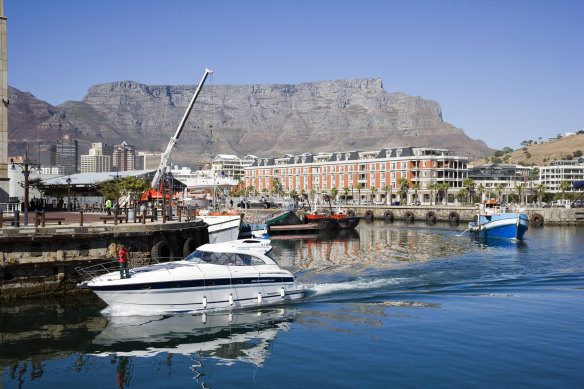Port guide: Cape Town, South Africa
One of the world’s most spectacular harbour towns has plenty in it, and even more around it, to ensure you have a very busy port day.
Who goes there
Cape Town is more commonly a mid-cruise port rather than one at which to embark or disembark. Azamara, Holland America, Norwegian, Oceania, Ponant and Silversea are among the lines that visit. Some 70 ships arrive in the October-to-May cruise season, for the most part small- to mid-sized. With the Red Sea now being avoided by cruise ships, that number will likely increase as ships sail around Africa while repositioning between Europe and Asia.

At the port in Cape Town.
Sail on in
If you arrive from the east, this is a thrilling sail around the Cape of Good Hope and into Table Bay. From any direction, cruise ships navigate between a headland and notorious prison Robben Island – where Nelson Mandela spent 18 years – towards often cloud-draped Table Mountain and Lion’s Head, a majestic backdrop to the city dwarfed beneath.
Berth rites
Cape Town Cruise Terminal is at Duncan Dock a five-minute walk from the V&A Waterfront, a lively restaurant, shopping and entertainment area close to the city centre. Sometimes, sea lions flop on the boardwalks. The well-organised terminal, opened in 2018, sits inside a converted industrial fruit-cooling facility, with immigration and baggage handling below and shops and restaurants above. An open deck gazes over the busy harbour.
Going ashore
Walk into town if you’re sprightly, otherwise get the hop-on hop-off bus. Downtown has significant Dutch and British colonial-era buildings, a lively morning handicrafts market in Greenmarket Square, and good museums, of which the best is Iziko South African National Gallery for its great collection of southern African art and indigenous crafts. The waterfront Two Ocean Aquarium is excellent.
Don’t miss
The cheerful neighbourhood of Bo-Kaap, first settled by 18th-century descendants of Dutch East Indian slaves and later by other Muslims from India, Turkey and Madagascar. Its houses are painted in vivid, clashing colours. The olive-green 1794 Auwal mosque is South Africa’s oldest. Heritage is traced at the Bo-Kaap Museum – and in neighbourhood restaurants that serve spicy Cape Malay curries and stews.
Get active
The ascent of Table Mountain by cable car is a must in Cape Town, but the very fit can tackle any of several scenic but demanding hiking paths to the summit. Otherwise, the Upper Cable Station is the starting point of three easier hiking trails to various viewpoints. Table Mountain National Park stretches across most of the Cape Peninsula and has many more hiking and mountain-biking trails through one of the world’s richest floral regions.
Retail therapy
Leather goods, rooibos bush tea made from endemic fynbos, and local arts and crafts such as beadwork, masks, Zulu ceremonial spoons, and the distinctive Shweshwe fabric of the Xhosa community make for great souvenirs. If you want to annoy the neighbours, buy your kids a vuvuzela, a plastic horn commonly blown at South African football matches. Boutiques have interesting fashions, accessories and homewares showing blended European and African influences, especially along Church, Long and Kloof streets.
Further afield
Cape Town has better sights around it than in it, so you should certainly consider a shore excursion. In suburban Constantia, you’ll find historic wineries and nearby Kirstenbosch National Botanical Garden, whose plants are nearly all indigenous and whose setting under the flank of Table Mountain is inspired. Cape Peninsula features penguins at Boulders Beach, shark cage-diving at Simon’s Town, and dramatic Chapman’s Peak Drive. The superb wine region around Stellenbosch, 50 kilometres away, has gobsmacking scenery – especially as you cross the Helshoogte Pass – and old Dutch mansions with glorious gardens and cellar doors.
Sign up for the Traveller newsletter
The latest travel news, tips and inspiration delivered to your inbox. Sign up now.